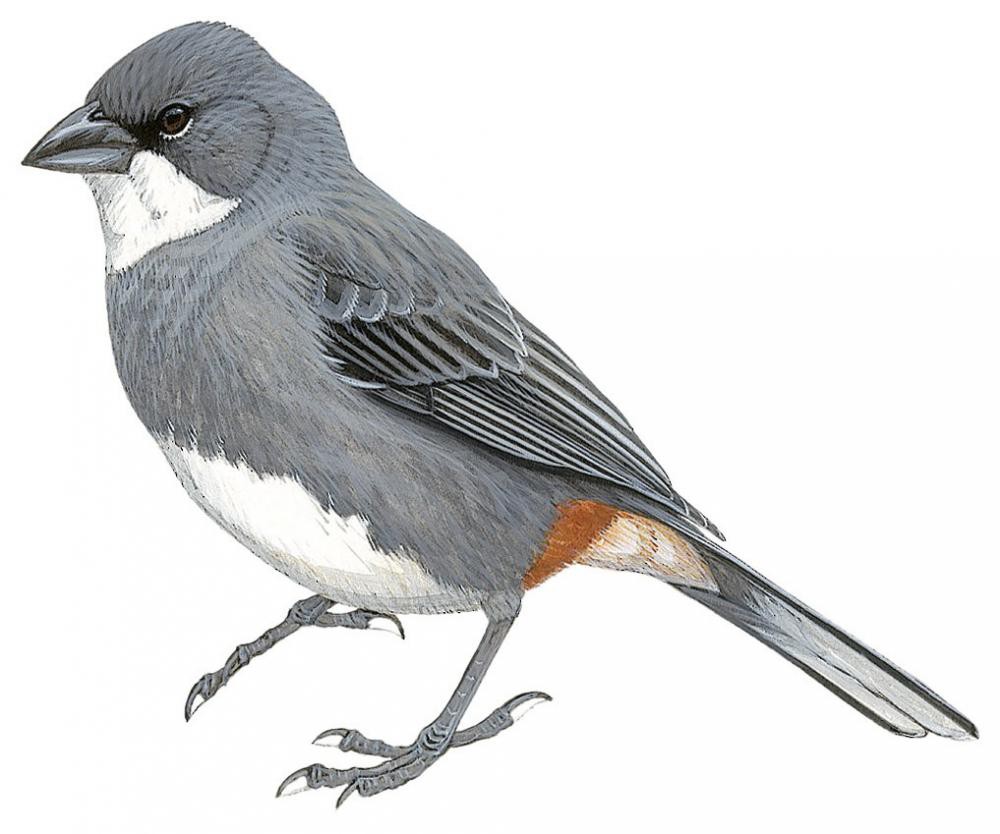Common Diuca-Finch / Diuca diuca

Common Diuca-Finch
SCI Name:
Protonym: Fringilla Diuca SaggioStoriaNat.Chile p.249
Taxonomy: Passeriformes / Thraupidae / Diuca
Taxonomy Code: codfin1
Type Locality: Chile.
Author: Molina
Publish Year: 1782
IUCN Status: Least Concern
DEFINITIONS
DIUCA
(Thraupidae; Ϯ Common Diucafinch D. diuca) Specific name Fringilla diuca Molina, 1782. Reichenbach's 1850, plate LXXVIII, labelled Passerinae: Pyrrhulinae Coccothraustinae, shows a variety of heavy-billed finches, including Diuca, Crithagra, Lamprospiza, Linurgus, and Caryothraustes. "Diuca, Reichenb. (Euspina, p. Gr.) 1. FRINGILLA diuca, Molina. (Emberiza diuca, Orb. 1838. Euspiza diuca, Gr.) Kittl. Mem. Ac. Petersb. 1831. t. 11. Voy. Favor. t. 17. — Mag. Zool. 1836. t. 9. et 1837. t. 69. ex Chili, Patagonia." (Bonaparte 1850); "Diuca Reichenbach, 1850, Av. Syst. Nat., pl. 78. Type, by subsequent designation (G. R. Gray, 1855, Cat. Genera Subgenera Birds, p. 79), Emberiza speculifera Lafresnaye and d'Orbigny." (Paynter in Peters, 1970, XIII, p. 118): however, Reichenbach's plate shows the features of the Common Diucafinch, which must be considered the type by tautonymy (see Chionodacryon).
Var. Dinca.
Synon. Hedyglossa.
diuca
Araucano names Diuca and Siuca for the Common Diucafinch (Diuca).
DIUCA
(Thraupidae; Ϯ Common Diucafinch D. diuca) Specific name Fringilla diuca Molina, 1782. Reichenbach's 1850, plate LXXVIII, labelled Passerinae: Pyrrhulinae Coccothraustinae, shows a variety of heavy-billed finches, including Diuca, Crithagra, Lamprospiza, Linurgus, and Caryothraustes. "Diuca, Reichenb. (Euspina, p. Gr.) 1. FRINGILLA diuca, Molina. (Emberiza diuca, Orb. 1838. Euspiza diuca, Gr.) Kittl. Mem. Ac. Petersb. 1831. t. 11. Voy. Favor. t. 17. — Mag. Zool. 1836. t. 9. et 1837. t. 69. ex Chili, Patagonia." (Bonaparte 1850); "Diuca Reichenbach, 1850, Av. Syst. Nat., pl. 78. Type, by subsequent designation (G. R. Gray, 1855, Cat. Genera Subgenera Birds, p. 79), Emberiza speculifera Lafresnaye and d'Orbigny." (Paynter in Peters, 1970, XIII, p. 118): however, Reichenbach's plate shows the features of the Common Diucafinch, which must be considered the type by tautonymy (see Chionodacryon).
Var. Dinca.
Synon. Hedyglossa.
diuca
Araucano names Diuca and Siuca for the Common Diucafinch (Diuca).
SUBSPECIES
Common Diuca-Finch (crassirostris)
SCI Name: Diuca diuca crassirostris
crassirostra / crassirostre / crassirostris
L. crassus thick, heavy; -rostris -billed < rostrum beak.
● ex “Coucou à Gros Bec” of Levaillant 1806, pl. 214 (syn. Eudynamys scolopaceus).
● ex “Alouette à Gros Bec” of Levaillant 1806, pl. 193 (syn. Galerida magnirostris).
● ex “Thick-billed Grosbeak” of Latham 1783 (Oryzoborus).
● ex “Thick-billed Thrush” of Latham 1783 (‡syn. Turnagra capensis).
Common Diuca-Finch (diuca)
SCI Name: Diuca diuca diuca
DIUCA
(Thraupidae; Ϯ Common Diucafinch D. diuca) Specific name Fringilla diuca Molina, 1782. Reichenbach's 1850, plate LXXVIII, labelled Passerinae: Pyrrhulinae Coccothraustinae, shows a variety of heavy-billed finches, including Diuca, Crithagra, Lamprospiza, Linurgus, and Caryothraustes. "Diuca, Reichenb. (Euspina, p. Gr.) 1. FRINGILLA diuca, Molina. (Emberiza diuca, Orb. 1838. Euspiza diuca, Gr.) Kittl. Mem. Ac. Petersb. 1831. t. 11. Voy. Favor. t. 17. — Mag. Zool. 1836. t. 9. et 1837. t. 69. ex Chili, Patagonia." (Bonaparte 1850); "Diuca Reichenbach, 1850, Av. Syst. Nat., pl. 78. Type, by subsequent designation (G. R. Gray, 1855, Cat. Genera Subgenera Birds, p. 79), Emberiza speculifera Lafresnaye and d'Orbigny." (Paynter in Peters, 1970, XIII, p. 118): however, Reichenbach's plate shows the features of the Common Diucafinch, which must be considered the type by tautonymy (see Chionodacryon).
Var. Dinca.
Synon. Hedyglossa.
Common Diuca-Finch (chiloensis)
SCI Name: Diuca diuca chiloensis
chiloensis
Chiloé I., Chile.
Common Diuca-Finch (minor)
SCI Name: Diuca diuca minor
minor
L. minor smaller < comp. parvus small. “Comparative names ... Specific names expressive of comparative size are also to be avoided, as they may be rendered inaccurate by the after-discovery of additional species. The names ... maximus, minor, minimus, etc. are examples of this objectionable practice” (Strickland Code 1842).
● ex “Short-eared Owl” of Pennant 1761 (syn. Asio flammeus).
● ex “Little Thrush” of Catesby 1731-1743, Edwards 1758-1764, Latham 1783, and Pennant 1785, “Turdus iliacus carolinensis” of Brisson 1760, and “Grivette de l’Amérique” of de Buffon 1770-1783 (syn. Catharus fuscescens).
● ex “Whip-poor-will” of Catesby 1731 (Chordeiles).
● ex “Coucou des palétuviers de Cayenne” of d’Aubenton 1765-1781, pl. 813, “Petit Vieillard” of de Buffon 1770-1783, and “Mangrove Cuckow” of Latham 1782 (Coccyzus).
● "54. PICUS. ... minor. 12. P. albo nigroque varius vertice rubro, ano albido. Picus albo nigroque varius, rectricibus tribus lateralibus seminigris. Fn. svec. 83. Hasselqv. iter. 242. Picus varius tertius. Raj. av. 43. Picus varius minor. Alb. av. I. p. 20. t. 20. Habitat in Europa.” (Linnaeus 1758) (Dryobates).
● ex “Fregata minor” of Brisson 1760, “Petite Frégate” of de Buffon 1770-1783, “Man of War Bird” of Edwards 1760, and “Lesser Frigate Pelican” of Latham 1785 (Fregata).
● ex “Petit Indicateur” of Levaillant 1807, pl. 242 (Indicator).
● ex “Pie-grièsche d’Italie” of d’Aubenton 1765-1781, pl. 32, fig. 1 (Lanius).
● ex “Perruche à ailes noires” of de Buffon 1770-1783, “Petite perruche de l’isle de Luçon, 4ème ésp.” of Sonnerat 1776, and “Luzonian Parrakeet” of Latham 1781 (syn. Loriculus philippensis).
● ex “Apiaster Philippensis minor” of Brisson 1760 (syn. Merops viridis americanus).
● ex “Little Woodcock” of Pennant 1785, and Latham 1785 (Microptera).
● ex “Troupiale de la Caroline” of d’Aubenton 1765-1781, pl. 606, fig. 1, “Petit Troupiale noir” of de Buffon 1770-1783, and “Lesser black Oriole” of Latham 1782 (syn. Molothrus ater).
● ex “Lesser Bird of Paradise” of Latham 1783 (Paradisaea).
● ex “Barbican à ventre rose” of Levaillant 1806 (Pogonornis).
● ex “Porphyrio minor” of Brisson 1760 (syn. Porphyrula martinica).
● ex “Colymbus fluviatilis” of Brisson 1760 (syn. Tachybaptus ruficollis).
● ex “Huppe d’Afrique” of Audebert & Vieillot 1800-1802 (syn. Upupa africana).
● ex “Ringvia” of Brünnich 1764, and “Lesser Guillemot” of Pennant 1785 (syn. Uria aalge).
UPPERCASE: current genus
Uppercase first letter: generic synonym
● and ● See: generic homonyms
lowercase: species and subspecies
●: early names, variants, mispellings
‡: extinct
†: type species
Gr.: ancient Greek
L.: Latin
<: derived from
syn: synonym of
/: separates historical and modern geographic names
ex: based on
TL: type locality
OD: original diagnosis (genus) or original description (species)












